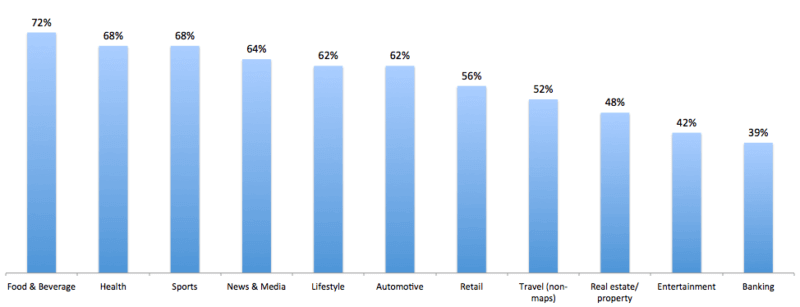
- The Importance Of Rank Tracking Local Keywords In 2018 - June 5, 2018
- How to Spot Opportunities from your Competitors’ Backlinks - July 19, 2017
- Why You Should Monitor Your Brand Daily - May 26, 2017
There has been one search trend that has stayed the same for many years: the shift from desktop to mobile. A report shows that around 58% of search queries in the US are made using mobile devices. Broken down into categories, the food and beverage segment shows the most mobile search at 72% while the banking sector has the lowest figure at 39%.

Source: Hitwise
Whichever way you look at it, the mobile shift is real and inevitable – even more so now that Google has suggested that website developers should make it a priority. In November 2016, the search giant announced that they will be “experimenting” with a mobile-first index.
Let’s take a look at this move and what it means for site owners.
Mobile-First Indexing: A First Look
Google sifts through websites on the surface web and collects information from each one. This particular collection of information is called the index. When a user enters a query or a keyword, Google refers to this index and returns results based on its algorithm.
Ever since the search engine’s inception, this index has been viewed from the perspective of a desktop user. A mobile-first index changes up the whole thing and shifts the perspective to that of a mobile device user. With a mobile-first index in play, the search engine looks at the mobile version of websites before checking the desktop version. Before this “experiment,” mobile versions of websites were secondary to their desktop counterparts.
Going Into Specifics
 Before anything else, know that Google thinks mobile-first indexing won’t have a massive impact on rankings – at least for now. It will only change how the engine crawls information on the web. Should there be shifts in rankings, Google expects that these will not be noticeable.
Before anything else, know that Google thinks mobile-first indexing won’t have a massive impact on rankings – at least for now. It will only change how the engine crawls information on the web. Should there be shifts in rankings, Google expects that these will not be noticeable.
Now, the goal of this update is to fully turn to mobile counterparts of websites as primary sources of indexed information. At the moment, this is not yet possible. During this temporary, “experimental” phase, there are two indexes used for searches: mobile-first and desktop-first. Should this experiment be a success, Google is set on transitioning to using mobile versions of websites in their algorithms.
As with most updates Google launches, the rollout of the mobile-first index is a gradual one. In the announcement blog, Google stated that they would start small before ramping it up to larger sample sizes. Remember that the mobile-first index is still in a trial period of sorts.
The search giant wants to iron out any issues before it takes full effect, so the question of when it will be fully rolled out remains unanswered for now.
The Effect on SEO – What Should Be Your Strategy?
Should site owners and marketers be worried about the possible full rollout of the mobile-first index? Maybe, maybe not – it all depends on how your website functions right now. For this particular update, the focus should be on how websites are designed and/or structured. It is important to cater to the ever-growing audience that is mobile users.
If your website’s functionality is limited to desktop users only, you will largely be unaffected by the change. Google’s indexing practice for desktop-only websites will stay the same. Although, if you keep your site this way, know that you are not reaping any of the benefits of Google’s mobile-friendly update. This algorithm change gives a small ranking boost to websites that cater to mobile users.
Those with responsive sites have nothing to worry about as well. If the content is the same in both the mobile and the desktop versions, it is safe to say that the rankings would be unchanged even with the mobile-first index.

Websites that run different content between mobile and desktop, however, may have to tweak a few things. It is quite common to put shorter content (and fewer links) on mobile content and this could be a problem. Google will still see the website, but with much less content to crawl. Once mobile-first indexing is rolled out in full, the priority would be information from mobile websites, from the titles and H1s to tags and meta descriptions.
It is for this reason that Google recommends the use of a responsive design. But if that is not possible, site owners should make sure that the structures of their websites are flawless. The search giant recommends the use of the Structured Data Testing Tool to compare and adjust the content across platforms. Site owners can also turn to the use of robots.txt to check whether the mobile version of the website is visible to Google. As for canonical links, these will require no change.
But as with any change in the industry, what matters is how well site owners and marketers adapt to the change.
The search landscape shifts anew with Google’s mobile-first indexing “experiment.” But as with any change in the industry, what matters is how well site owners and marketers adapt to the change. As long as adjustments are made properly and within the guidelines of search engines, site owners have nothing to worry about.
If you want to ensure your site is optimized for mobile, Siteoscope is the tool to use. Sign up and get a free 30-day trial to start tracking the performance of your website.




